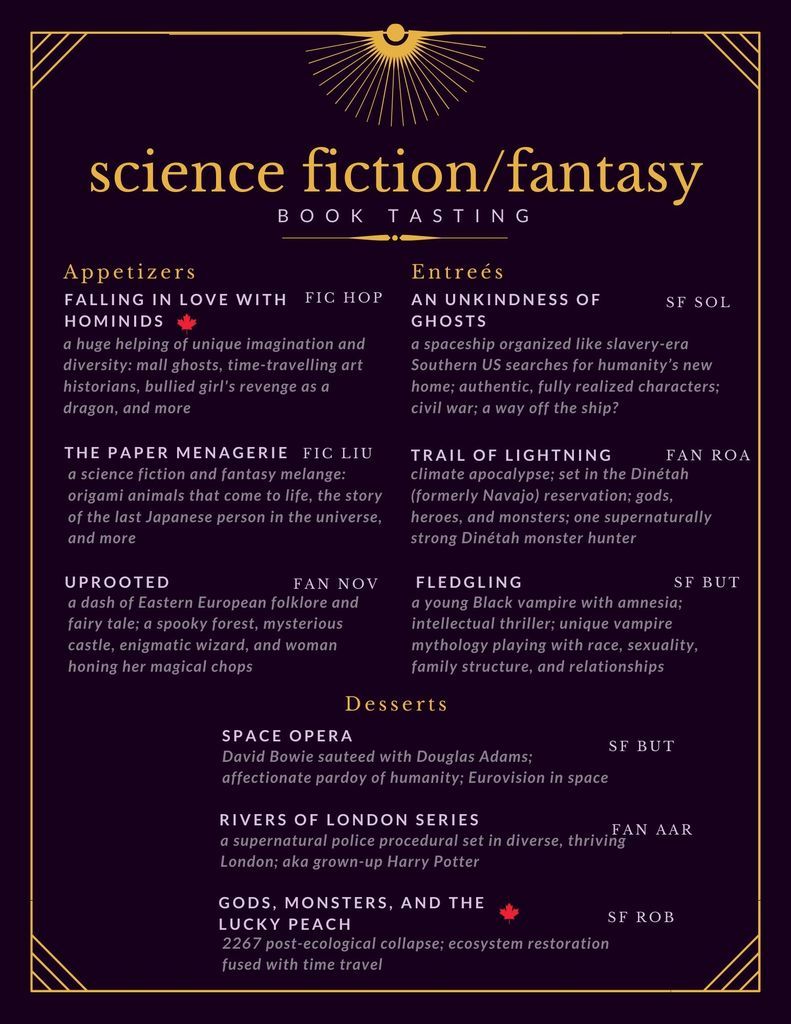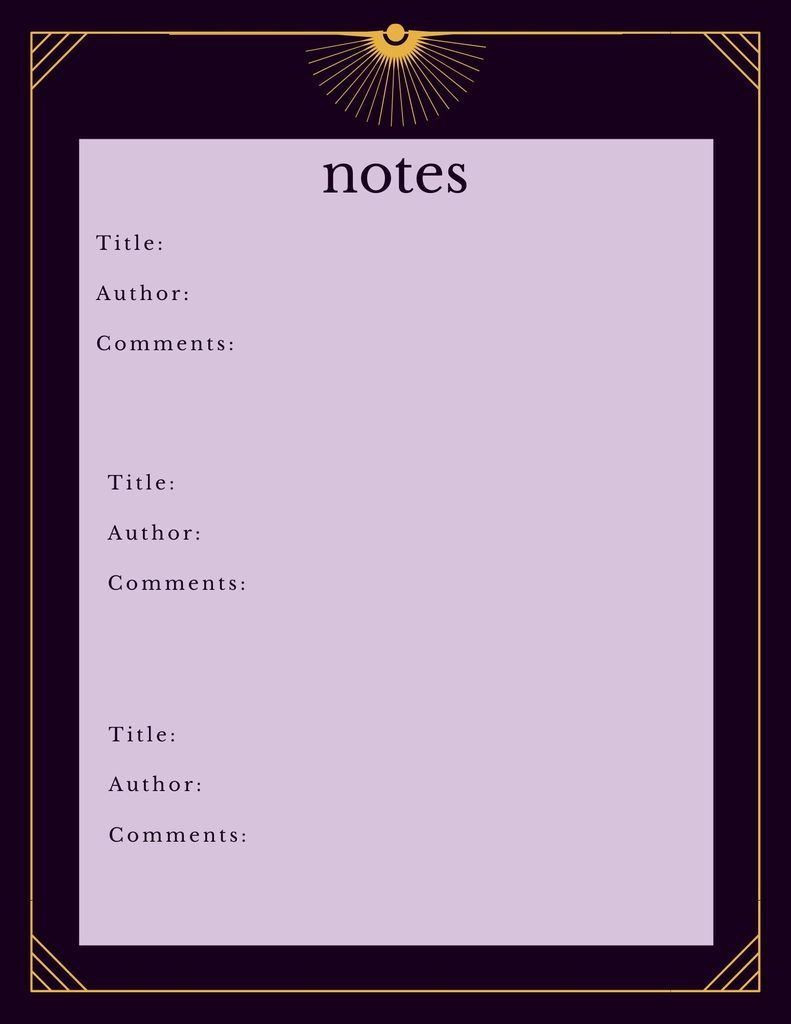What is a book tasting? It’s an event where people come and “taste” different books and genres at tables as if they are sampling from a literary buffet. There are plenty of different ways to organize a book tasting. But the main point is to introduce people in a fun and quick way to new books they might not have discovered otherwise. Below are tips and step-by-step instructions for hosting a book tasting for adults at a public library.
Planning
Who
Think a bit about what demographics you want to reach with your book tasting. Are you trying to reach out to people in their 20s and 30s? Older adults? People living in retirement homes? The cool thing about book tastings are that they can be adapted to many different ages! But it is a good idea to think about which group of adults you’re aiming for (even if that is a wide range of all adults).
What
No matter what your public library’s budget, there are a variety of props you can make or buy to create a fun atmosphere. We got most of our supplies at the dollar store. We also scrounged some stuff that we already had around. These supplies (some totally optional) include:
plastic tablecloths (red and white checkered are great to give a restaurant feel) flickering battery-powered tea light “candles” (we decided real candles were too risky) tiny vases/bottles/some receptacle for a flower one carnation per table (or any other single flower depending on your budget) chef’s hats (you can buy paper ones cheap) aprons (great to bring from home if you can) a dinner bell (a service desk bell you have around will work in a pinch) pencils or pens in a cup menus table place cards and/or placemats (with the “cuisines,” AKA genres/formats, printed on them).
The other big “what” you have to prepare is the books themselves and the corresponding menus! Think about the demographics of attendees when you’re deciding which books to offer as “tastings”—not just who you think will be attending but how many. You don’t want to have too many or too few tables for how many people attend. For this reason, I recommend doing registration for your book tasting. You also want to have offerings that are going to be new for people, even if they are well versed in a certain genre or format. Use your instincts! If you’re aiming for a general audience, plan to include some well known books in the genre as well as some that are obscure. Double check your offerings to make sure you’re including diverse reads by and featuring women, people of color, and/or LGBTQ folks. This is also a good opportunity to promote local authors’ works. Make sure you request the books you want to offer well in advance. You don’t want to have to change your menu at the last minute because your hold didn’t arrive in time (ahem—like I did). My colleagues and I decided on four tables showcasing two menus of different genres/formats per table. One genre/format per table would definitely work too, for a bigger crowd or fewer options. (We chose poetry, mystery, romance, science fiction and fantasy, graphic novels/memoirs, biography/memoir, new literary fiction, and cookbooks). We each researched and prepared a “menu” of nine books for each genre/format—three books for appetizers, three for entrees, and three for desserts. As you’ll see, we aimed for short descriptions that played with how food is usually described on menus. You’ll see we included call numbers so attendees could use that information later, as well as maple leafs to mark Canadian content. (We omitted authors to save room). On the back of the menus we included a space for notes. Tip: Canva’s free version has plenty of templates for menus, which is what we used. See below for an example menu:
Where
If you’re wanting to reach the elusive millennial crowd (especially those who are childless), this event is a great one to hold outside the library in a space those people frequent—i.e. a pub or brewery! There’s nothing better for creating a restaurant atmosphere than holding your book tasting in an actual drinking or eating establishment. Reach out to see if you can establish some new partnerships. This event also works well at the library. Depending on your registration, you can decide whether to hold it out in the open of the library, or in a program room if you have one. Holding it out in the open can attract patrons who happen to be in the library, but if you have a bigger group, it will be easier to manage everyone in a closed space.
When
When is a good time hold your book tasting for adults at a public library? This depends on who you are trying to attract. As is the case with a lot of adult programming, if you hold an event in the afternoon on a weekday, you’re going to miss adults who work 9–5. On the flip side, afternoon events are ideal if you’re after the retired crowd, especially older adults who don’t like to go out at night. If you’re really going for the restaurant atmosphere, evening works better to show off props like candles. One other tip: on or around Valentine’s Day is a great time for a book tasting, as you can promote it as a (free!) Valentine’s Day outing for couples.
How
Work together with your colleagues to plan a book tasting! Take advantage of your coworkers’ different areas of literary interest and expertise to create diverse, exciting menus.
Actual Event
Who
Ideally, it is great to have one “server/chef” per table, but one or two people can manage a book tasting if the group of attendees isn’t too big. Anyone who has a flair for the dramatic is going to have an especially fun time pretending they’re working at a fancy restaurant. But don’t feel like you have to do that if you’re not comfortable. It is especially useful to have the people who chose the books and wrote the menus working at the actual event, as some folks are going to want more details about the “menu items.”
What
Set up your chairs and tables with your tablecloths, vase with flower, “candle,” menus, place cards/mats, and stack of books artfully displayed. Make sure there’s enough room to comfortably move around from table to table. (Don’t forget about making room for anyone using a mobility device like a wheelchair to get around too). We had four chairs at each table, but also planned to be flexible since, unlike a class at a school, it’s hard to predict how many people you’re going to have. I always like to err on the side of making sure the room looks full and bringing out extra chairs/tables if needed, rather than having a bunch of extra stuff sitting around making the space look empty.
Where
See above in the planning section!
When
Okay, this isn’t technically when, but it is an issue of time. How long should you plan to have attendees at each table? We decided on 15 minutes per table, which seemed reasonable for two menus of nine books at each table. Since we had four tables, that allowed about an hour for the event. Depending on the group, you might have people who want to stay longer at tables. Or, there may be people who are ready to move on to the next one before 15 minutes is up. Be flexible and read the room!
How
Welcome attendees into the space and seat them at a table as if they’re at a restaurant. Introduce yourself as a chef/server if you want. You can ask things like “Do you have a reservation?” or “Which ‘cuisine’ would you like to sample first?” if you want to ham things up a bit. Make sure to point out that they each have their own menu for each genre/format to write on and take home with them. Once you’ve got everyone there, have one person explain to the group how it’s going to work. They’ll have about 15 minutes at each table to read the menu, choose some books from the menu that are on the table, read the first page and back cover blurb, and write notes. The dinner bell will tell them when to switch tables. Encourage folks to share amongst themselves and ask questions from their “server” if they want more information about any of the books. We decided to let attendees check out any books they wanted, even if a certain item had a hold list. It seemed too unfair to dangle the physical copy of the book in front of them and then say, sorry, you have to go on the hold list for it. (This meant we did have to check out items manually for a few people). Let people know they have to wait until the end of the event to check out any items. If you anticipate more than one person will want to check out the same item, have some kind of plan to randomly decide (pick numbers out of a hat, flip a coin, etc.). In my experience adults are usually good at compromising, but you never know! Last but not least: have fun! And like all programs, after your book tasting for adults at a public library is done, write down what worked and what didn’t so you can improve for next time. Want more? Check out all things libraries at Book Riot.



